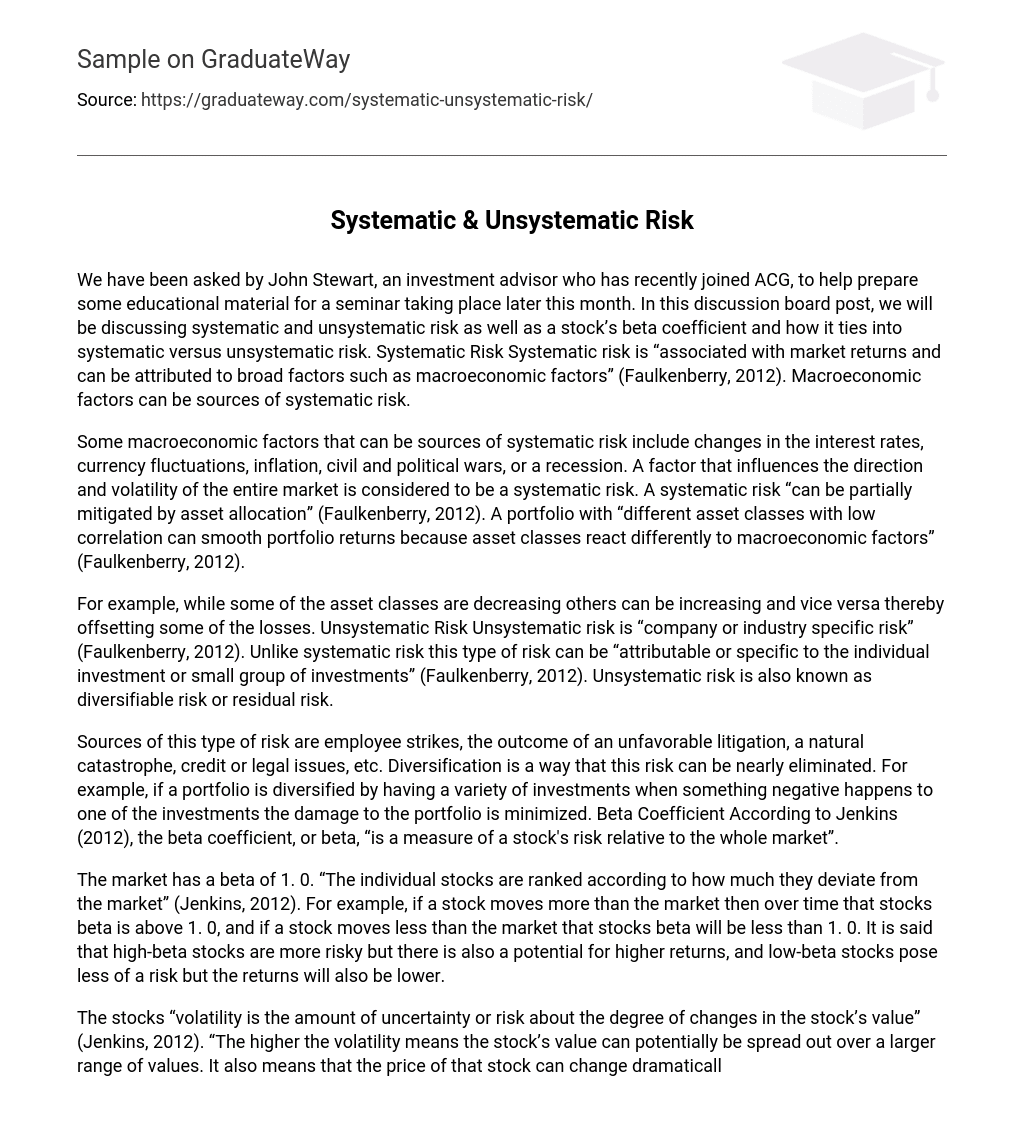We have been asked by John Stewart, an investment advisor who has recently joined ACG, to help prepare some educational material for a seminar taking place later this month. In this discussion board post, we will be discussing systematic and unsystematic risk as well as a stock’s beta coefficient and how it ties into systematic versus unsystematic risk.
Systematic Risk: Systematic risk is “associated with market returns and can be attributed to broad factors such as macroeconomic factors” (Faulkenberry, 2012). Macroeconomic factors can be sources of systematic risk.
Some macroeconomic factors that can contribute to systematic risk include fluctuations in interest rates, changes in currency values, inflation, civil and political conflicts, and economic downturns. These factors influence the overall market direction and volatility, making them systematic risks. According to Faulkenberry (2012), asset allocation can partially reduce systematic risk. By diversifying a portfolio with asset classes that have low correlation, portfolio returns can be smoothed out because different asset classes respond differently to macroeconomic factors.
In the field of asset classes, there is a possibility of some decreasing and others increasing simultaneously, counterbalancing certain losses. This phenomenon is known as systematic risk. Conversely, unsystematic risk refers to risk that is specific to a particular company or industry. It can be attributed to an individual investment or a small group of investments. Unsystematic risk is also referred to as diversifiable risk or residual risk.
By diversifying a portfolio with various investments, the negative impacts on one investment can be mitigated by spreading it across the overall portfolio. This can significantly reduce sources of risk, such as employee strikes, unfavorable litigation outcomes, natural catastrophes, credit or legal issues, and more.
Jenkins (2012) stated that the beta coefficient or beta serves as an indicator of a stock’s risk in comparison to the entire market.
According to Jenkins (2012), stocks in the market are categorized based on their deviation from the market using a beta of 1.0. Stocks with a beta greater than 1.0 have higher movement compared to the market, while those with a beta less than 1.0 have lower movement. Riskier stocks are typically associated with higher-beta values and may provide higher returns, whereas less risky stocks tend to have lower-beta values and potentially offer lower returns.
Stock volatility, as defined by Jenkins (2012), pertains to the uncertainty or risk linked with fluctuations in a stock’s value. Higher volatility implies a potential for significant variations and rapid price changes in the stock. Conversely, lower volatility suggests more steady and gradual shifts in its value. Within the Capital Asset Pricing Model (CAPM), the beta coefficient holds essential importance.
The capital asset pricing model (CAPM) is used to calculate the cost of equity and demonstrates the relationship between risk and expected returns. The beta coefficient is essential in this model as it connects the relationship between risk and anticipated return for a specific stock (Mistakesintrading.com, 2012). The expected rate of return for a stock includes both the risk-free rate and a risk premium that is determined by the systematic risk linked to that particular stock.
According to the CAPM, there are two types of risk for a stock or portfolio: systematic risk and unsystematic risk. Unsystematic risk refers to the specific risk associated with an individual security and can be minimized by diversification. Conversely, systematic risk is the remaining risk that plays a crucial role in determining the relationship between risk and return (Mistakesintrading.com, 2012). By creating a portfolio that combines different stocks, it is possible to decrease unsystematic risk while retaining systematic risk.
In essence, diversifying the stock in a portfolio does not fully eliminate systematic risk. To summarize, companies can use different strategies to reduce unsystematic risk in their investment portfolios. However, it is very challenging to completely minimize or eliminate systematic risk. Asset allocation can partially mitigate systematic risk and diversification can nearly eliminate unsystematic risk. Nonetheless, investors will always encounter some degree of risk.
Risk is a crucial aspect of every business. When managers and investors possess awareness of these risks, they can begin implementing and managing them effectively. Through the establishment of suitable risk management measures, the company can successfully reduce the risk. Consequently, the risk can be efficiently controlled, monitored, and managed.
References
Colorado Technical University Online (2012) provides information on Finc605-1204B-01: Corporate portfolio management: Task list: Phase 1 discussion board. This information can be found at https://campus.ctuonline.du/pages/MainFrame.aspx?ContentFrame=/Home/Pages/Default.aspx.
Faulkenberry, K. (2012) discusses systematic and unsystematic risk, probability, and expected value. More information can be found at http://arborinvestmentplanner.com/systematic-and-unsystematic-risk-probability-and-expected-value-4/.
Jenkins, J. (2012) provides an understanding of the beta coefficient. The information can be accessed at http://www.investmentu.com/2012/February/beta-coefficient.html.
Mistakesintrading.com (2012) offers insights on the capital asset pricing model. The details can be found at http://www.mistakesintrading.com/wiki-stocks/capital-asset-pricing-model.php.





